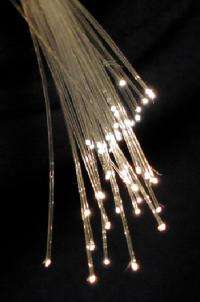August 14, 2008 weblog
Physicists Seek Answers to Quantum Correlations

After performing multiple tests on two entangled photons, physicists have yet again found that the photons seem to be communicating faster than the speed of light - at least 100,000 times faster. The researchers hope that their results might encourage theorists to come up with new explanations for the strange quantum mechanical effect.
The physicists, led by Nicolas Gisin from the University of Geneva, arranged their experiment by sending two photons down fiber optic cables to detectors in two Swiss villages located 18 km apart. Both photons started in Geneva, with one heading toward Satigny and the other toward Jussy. The study, which is published in Nature, builds on previous tests published a few months ago in Physical Review Letters.
When the researchers measured several properties of each photon at its destination, they found that the particles could instantly sense the other´s behavior without any known communication. Although this correlation obeys the laws of quantum mechanics, it seems to defy the nature of space and time, at least from humans´ everyday perspectives.
The physicists ruled out several possible classical explanations for the instantaneous communication. For one thing, they showed that the photons did not share information before leaving Geneva, and so they didn´t travel knowing about each other´s properties.
In another test, the scientists showed that no communication could have occurred through a different reference frame, as might happen because of the photons´ high speeds. According to Einstein´s theory of relativity, observers moving at high speeds can get different measurements of the same event because they have different reference frames. But, by performing tests over a complete rotation of the Earth, the researchers ruled out this possibility.
For now, Gisin´s team doesn´t have a good explanation as to how the seemingly instant correlations happen. Even though it doesn´t make sense to them, they hope that others might one day find a better understanding.
In a Nature News story, theorist Terence Rudolph at Imperial College London suggested that humans think that the three dimensions of space and one dimension of time that we´re used to should be the same everywhere, on all scales. But, he says, some things in quantum mechanics might transcend our view of space-time, and we just don´t get to see the whole picture.
"We think space and time are important because that´s the kind of monkeys we are," he said.
More information: Salart, D., Baas, A., Branciard, C., Gisin, N. & Zbinden, H. Nature, 454, 861-864 (2008).
via: Nature News





















